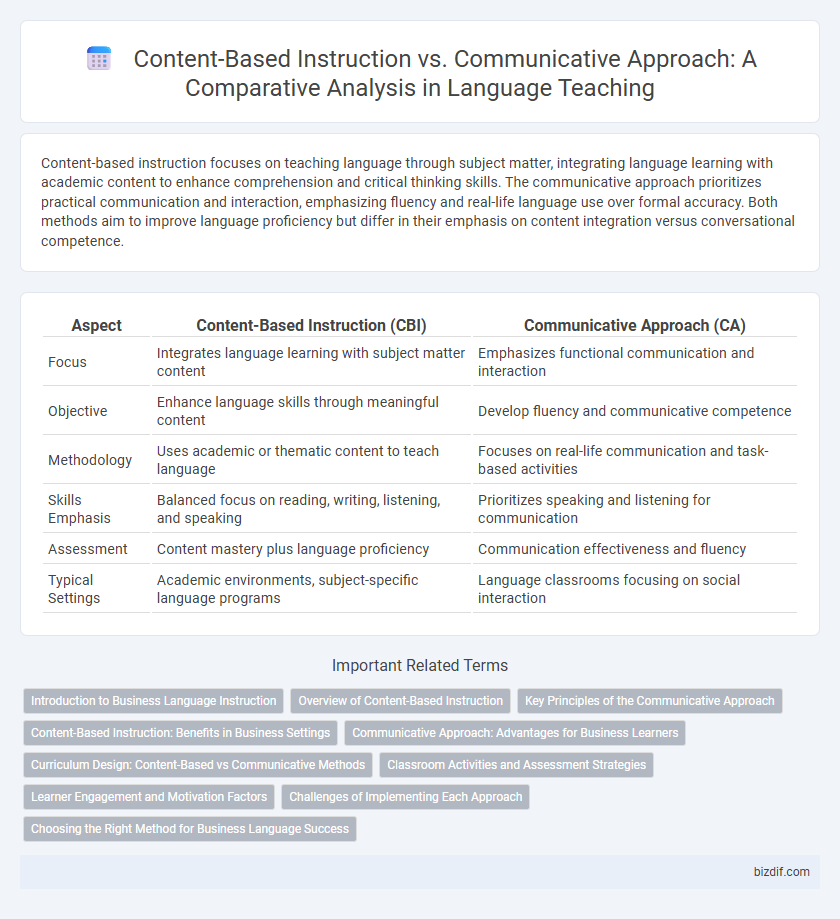Content-based instruction focuses on teaching language through subject matter, integrating language learning with academic content to enhance comprehension and critical thinking skills. The communicative approach prioritizes practical communication and interaction, emphasizing fluency and real-life language use over formal accuracy. Both methods aim to improve language proficiency but differ in their emphasis on content integration versus conversational competence.
Table of Comparison
| Aspect | Content-Based Instruction (CBI) | Communicative Approach (CA) |
|---|---|---|
| Focus | Integrates language learning with subject matter content | Emphasizes functional communication and interaction |
| Objective | Enhance language skills through meaningful content | Develop fluency and communicative competence |
| Methodology | Uses academic or thematic content to teach language | Focuses on real-life communication and task-based activities |
| Skills Emphasis | Balanced focus on reading, writing, listening, and speaking | Prioritizes speaking and listening for communication |
| Assessment | Content mastery plus language proficiency | Communication effectiveness and fluency |
| Typical Settings | Academic environments, subject-specific language programs | Language classrooms focusing on social interaction |
Introduction to Business Language Instruction
Content-based instruction in business language focuses on integrating language learning with specific business concepts, enabling learners to acquire terminology and skills relevant to real-world commercial contexts. The communicative approach prioritizes interaction and practical communication skills, emphasizing fluency and the ability to negotiate meaning in business settings. Combining both methods enhances learners' competence by developing subject-matter knowledge alongside authentic communicative abilities essential for professional environments.
Overview of Content-Based Instruction
Content-Based Instruction (CBI) integrates language learning with subject matter instruction, enhancing both linguistic and academic skills simultaneously. By using authentic content from disciplines such as science, history, or mathematics, CBI promotes meaningful language use in context, improving vocabulary and comprehension. This approach contrasts with the Communicative Approach by emphasizing content mastery alongside language proficiency rather than primarily focusing on conversational skills.
Key Principles of the Communicative Approach
The Communicative Approach emphasizes interaction as both the means and ultimate goal of learning a language, prioritizing fluency and real-life communication over rote memorization. Learners engage in authentic tasks such as role-plays, discussions, and problem-solving activities that foster meaningful language use and social interaction. This approach values learner autonomy, contextualized learning, and the development of pragmatic skills essential for effective communication in diverse real-world situations.
Content-Based Instruction: Benefits in Business Settings
Content-Based Instruction (CBI) in business language training enhances learners' industry-specific vocabulary and practical skills by integrating authentic materials into lessons. This approach improves workplace communication and problem-solving abilities by contextualizing language learning within real business scenarios. Employees develop targeted linguistic competence, enabling efficient collaboration and increased productivity in multicultural business environments.
Communicative Approach: Advantages for Business Learners
The Communicative Approach offers business learners practical language skills by emphasizing real-life communication and interaction relevant to professional contexts. This method enhances fluency and confidence in speaking, listening, and negotiating, which are critical for global business environments. Its focus on authentic language use and cultural nuances prepares learners to engage effectively in diverse workplace settings.
Curriculum Design: Content-Based vs Communicative Methods
Content-based instruction integrates subject matter and language learning, emphasizing curriculum design that prioritizes academic content alongside language skills development. In contrast, communicative approach curriculum design centers on interactive language use through real-life communication tasks, promoting fluency and practical language competence. Content-based curricula often feature thematic units drawn from disciplines like science or history, while communicative curricula focus on functional language activities and social interaction scenarios.
Classroom Activities and Assessment Strategies
Content-based instruction integrates language learning with subject matter, emphasizing activities such as project-based tasks, thematic reading, and subject-specific vocabulary exercises, while assessments often include content comprehension tests and presentations. The Communicative Approach prioritizes real-life communication skills through role-plays, group discussions, and interactive games, assessing learners via oral proficiency interviews, peer feedback, and spontaneous conversation evaluations. Both methodologies tailor classroom activities and assessments to promote effective language acquisition aligned with their pedagogical goals.
Learner Engagement and Motivation Factors
Content-based instruction enhances learner engagement by integrating meaningful subject matter, which increases intrinsic motivation through relevant and authentic materials. The communicative approach boosts motivation by promoting interaction and real-life communication, fostering learner confidence and practical language use. Both methods leverage learner participation, but content-based instruction emphasizes cognitive engagement with topics, while the communicative approach prioritizes social interaction for sustained motivation.
Challenges of Implementing Each Approach
Content-based instruction demands integrating subject matter expertise with language teaching skills, often requiring extensive teacher training and resource development. The communicative approach challenges stem from balancing fluency and accuracy, as well as adapting activities to diverse proficiency levels and cultural backgrounds. Both approaches face obstacles in assessment design that accurately measure language competence within authentic contexts.
Choosing the Right Method for Business Language Success
Content-based instruction integrates industry-specific materials and real-world tasks to enhance vocabulary and contextual understanding, crucial for mastering business language nuances. The communicative approach prioritizes interaction and practical speaking skills, fostering fluency through role-plays and simulations relevant to business scenarios. Selecting the appropriate method depends on learners' goals, with content-based instruction emphasizing subject matter expertise and the communicative approach focusing on effective verbal exchanges in professional settings.
Content-based instruction vs Communicative approach Infographic

 bizdif.com
bizdif.com